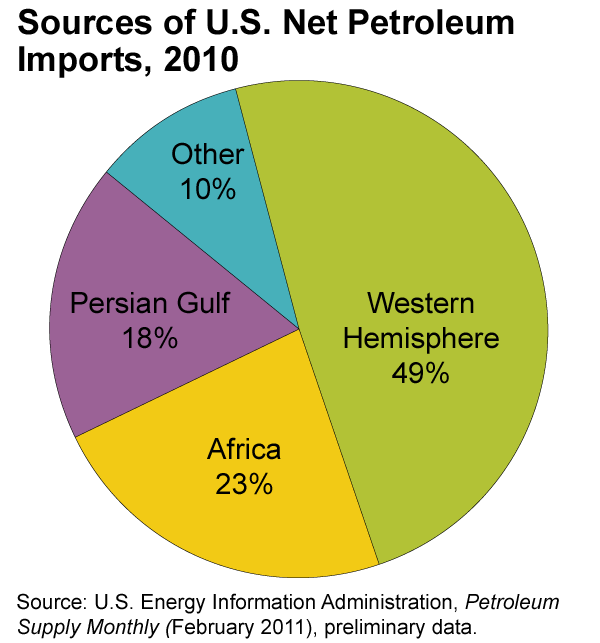博文
美国对外国石油的依存度究竟有多大?
|||



The United States consumed 19.1 million barrels per day (MMbd) of petroleum products during 2010, making us the world's largest petroleum consumer. The United States was third in crude oil production at 5.5 MMbd. But crude oil alone does not constitute all U.S. petroleum supplies. Significant gains occur, because crude oil expands in the refining process, liquid fuel is captured in the processing of natural gas, and we have other sources of liquid fuel, including biofuels. These additional supplies totaled 4.2 MMbd in 2010.
In 2010 the United States imported 11.8 million barrels per day (MMbd) of crude oil and refined petroleum products. We also exported 2.3 MMbd of crude oil and petroleum products during 2010, so our net imports (imports minus exports) equaled 9.4 MMbd.
Petroleum products imported by the United States during 2010 included gasoline, diesel fuel, heating oil, jet fuel, chemical feedstocks, asphalt, and other products. Still, most petroleum products consumed in the United States were refined here. Net imports of petroleum other than crude oil were 2% of the petroleum consumed in the United States during 2010.
About Half of U.S. Petroleum Imports Come from the Western HemisphereSome may be surprised to learn that 49% of U.S. crude oil and petroleum products imports came from the Western Hemisphere (North, South, and Central America, and the Caribbean including U.S. territories) during 2010. About 18% of our imports of crude oil and petroleum products come from the Persian Gulf countries of Bahrain, Iraq, Kuwait, Qatar, Saudi Arabia, and United Arab Emirates. Our largest sources of net crude oil and petroleum product imports were Canada and Saudi Arabia.
Sources of Net Crude Oil and Petroleum Product Imports:
- Canada (25%)
- Saudi Arabia (12%)
- Nigeria (11%)
- Venezuela (10%)
- Mexico (9%)
It is usually impossible to tell whether the petroleum products you use came from domestic or imported sources of oil once they are refined.
Reliance on Petroleum Imports has DeclinedU.S. dependence on imported oil has dramatically declined since peaking in 2005. This trend is the result of a variety of factors including a decline in consumption and shifts in supply patterns.2 The economic downturn after the financial crisis of 2008, improvements in efficiency, changes in consumer behavior and patterns of economic growth, all contributed to the decline in petroleum consumption. At the same time, increased use of domestic biofuels (ethanol and biodiesel), and strong gains in domestic production of crude oil and natural gas plant liquids expanded domestic supplies and reduced the need for imports.
http://www.eia.gov/energy_in_brief/foreign_oil_dependence.cfm
https://wap.sciencenet.cn/blog-339326-477234.html
上一篇:美国的发电厂究竟有多老?
下一篇:影响石油价格的七个主要因素
全部作者的精选博文
全部作者的其他最新博文
全部精选博文导读
相关博文
- • Running Purpose Test forDIKWP Artificial Consciousness(初学者版)
- • Running Wisdom Test for DIKWP Artificial Consciousness(初学者版)
- • Running Knowledge Test for DIKWP Artificial Conscious(初学者版)
- • Running Information Test for DIKWP Artificial Consciou(初学者版)
- • Running Data Tests for DIKWP Artificial Consciousness (初学者版)
- • DIKWP-Based White Box Evaluation(初学者版)